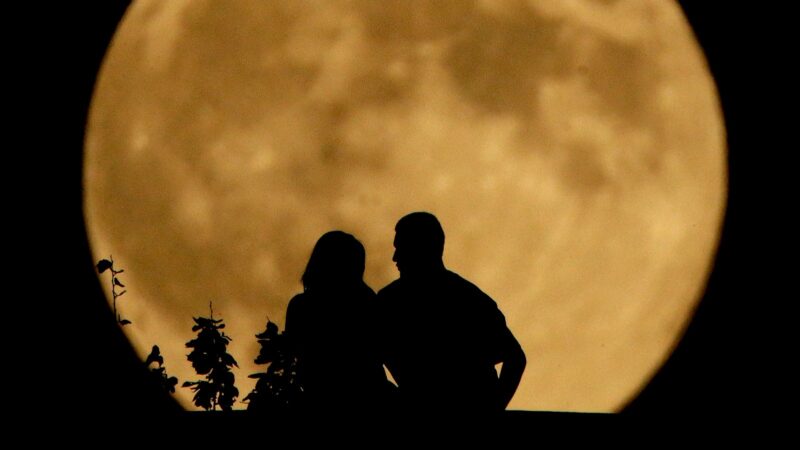A couple sits on a bluff overlooking the Missouri River as the full moon rises in the distance Monday, Sept. 8, 2014, in Kansas City, Mo. Monday night’s full moon, also known as a Harvest Moon, will be the third and final “supermoon” of 2014. The phenomenon, which scientists call a “perigee moon,” occurs when the moon is near the horizon and appears larger and brighter than other full moons. (AP Photo/Charlie Riedel)
Copyright 2014 AP. All rights reserved.
Each Monday, I pick out North America’s celestial highlights for the week ahead (which also apply to mid-northern latitudes in the Northern Hemisphere). Check my main feed for more in-depth articles on stargazing, astronomy, eclipses and more.
The Night Sky This Week: Oct. 6-12, 2025
This week begins with the dramatic rise of October’s harvest moon, the most famous full moon of the year. In its wake comes the Draconid meteor shower, a close meeting of the moon with the Pleiades star cluster and the re-emergence of the constellation of Orion, the hunter.
Here’s everything you need to know about the night sky, stargazing and astronomy this week:
Tuesday, Oct. 7: The Rise Of The ‘Harvest Moon’
Stellarium
Tuesday, Oct. 7: The Rise Of The ‘Harvest Moon’
Although the full moon was officially last night, tonight is the time to see it appear in the east during dusk. Give yourself a clear eastern horizon for the best view. October’s moon is usually called the hunter’s moon; it’s the harvest moon in 2025 because it’s the closest to the equinox on Sept. 22.
Wednesday, Oct. 8: Thursday, Oct. 9: Draconid Meteor Shower Peaks
The Draconids peak overnight tonight, sending slow-moving meteors from the constellation Draco, the Dragon, which coils around Polaris, the North Star. With a typical rate of about 10 meteors per hour, this is not a major shower, but it’s very convenient. Since the radiant point of the Draconids is visible right after sunset, high in the north, expect “shooting stars” as soon as it gets dark. Occasionally, the Draconids surprise with spectacular outbursts, so it’s worth looking up.
Thursday, Oct. 9: Moon Meets the Pleiades
Stellarium
Thursday, Oct. 9: Moon Meets the Pleiades
An 88%-lit waning gibbous moon will tonight reach within a degree of the Pleiades (also called M45 and the “Seven Sisters”) in Taurus. The moon’s glare will partly obscure the star cluster, so use binoculars to see its blue-white stars. Keep on watching throughout the night, and you’ll see it move across the cluster with rare precision.
Friday, Oct. 10-Saturday, Oct. 11: Delta Aurigid Meteor Shower Peaks
The Delta Aurigids peak overnight, though with only about two meteors per hour, this meteor shower is a mere celestial footnote. Any “shooting star” you do see is likely from this shower, radiating from close to Capella, the brightest star in the constellation Auriga, in the eastern sky.
The stars of the constellation Taurus.
getty
Constellation of the Week: Taurus
As the moon passes through Taurus, the bull, this week, it’s a perfect chance to explore this constellation. Look east after dark for the V-shaped Hyades star cluster marking the bull’s head, with bright Aldebaran as the eye of the bull. The constellation is also home to the Crab Nebula, a remnant of a supernova recorded in 1054 CE. Above it lies the Pleiades.
The times and dates given apply to mid-northern latitudes. For the most accurate location-specific information, consult online planetariums like Stellarium.
Wishing you clear skies and wide eyes









